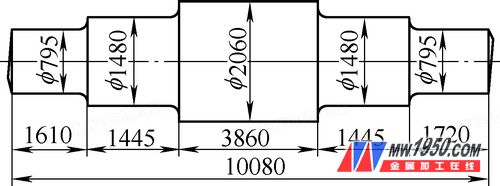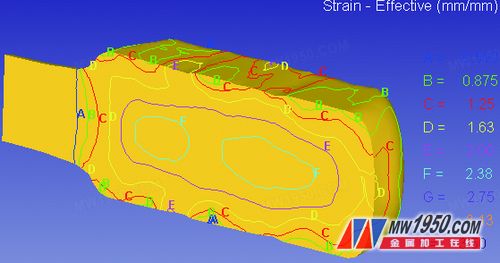Author: CITIC Heavy Engineering Research Center for large castings and forgings (Henan 471039) Li Changyi Liu Wang Zhaojun Wei Qin Hong Fu
The plate mill is a key product produced by our company. Especially in recent years, the rolling mill equipment in the metallurgical industry has begun to develop in the direction of large-scale, high-speed, continuous and automation, and the plate mill has been rapidly developed. The large supporting roller, as the main force component of the plate mill, directly affects the shape quality of the steel plate. Its design function and manufacturing technology must achieve high strength and stable stiffness to meet the wear resistance. This has led to an increase in its size, in which the diameter of the support roll of the 3500mm plate mill has exceeded 2000mm and the weight has reached more than 100 tons. How to make the large supporting roller steel ingot fully forge meet the ultrasonic testing requirements, which is of great significance to improve the manufacturing level of the large supporting roller and the economic benefit of the enterprise. Through the introduction of the production process of our company forging a 3500mm rolling mill backup roll for a company, a preliminary study on the forging process technology of the large supporting roll was carried out.
1. 3500mm plate mill support roller process difficulties
The support roller of the 3500mm plate mill has large specifications and high quality requirements. First, the net weight of the parts is 115.25t, the weight of the blank is 158.4t, and the blank size is φ2060mm×3860mm×10080mm (see Figure 1). Secondly, the hardness of the roll body is required to be 50~55HSD, the depth of the hardened layer is ≥90mm, the hardness of the roll neck is 47~52HSD, and the hardness of the roll body is ≤3HSD. Again, non-destructive testing is performed in accordance with JB / T4120-2006 standards. Finally, metallographic examination requires 100 times no defects such as porosity, inclusions, looseness and cracks; at 500 times, the carbides are evenly distributed and the surface is in a state of compressive stress.

Figure 1 3500mm plate mill support roll forgings
With the large-scale development of the support roller and the continuous improvement of the quality requirements, the manufacturing difficulty is becoming more and more difficult, which brings great difficulty to the process design and operation of the smelting and pouring, such as serious segregation of components, concentration of inclusions and excessive The hydrogen content control requirements are low; the support roll forging technology is more complicated, and there must be a reasonable forging process to break up the carbide, forge loose and void, to refine the structure, improve the distribution of inclusions in the steel, and The forging purpose of the new crack source is to make the support roll forging have high mechanical properties and fatigue resistance.
2. Forging process of support roll for 3500mm plate mill
The manufacturing process of large-sized backup rolls is: preparation → rough steel liquid (electric furnace) → ladle refining → vacuum ingot → press forging → post-forging heat treatment → rough processing → ultrasonic inspection → preliminary heat treatment (tempering) → semi-finishing → Differential temperature quenching→tempering→finishing→ultrasonic testing→packaging and shipping.
(1) 3500mm support roll process plan and numerical simulation With the continuous increase of the cross section of the large support roll, the steel ingot used is also increasing, and there are inevitably metallurgical defects such as looseness, void and carbide segregation inside. In order to forge metallurgical defects inside the ingot, the forging workers have successfully researched and applied to the production of large forgings by FM method, WHF method, KD method, SUF method, JTS method and so on. Since the diameter of the blank of the 3500mm support roller to be produced this time reaches φ2000mm or more, the total molten steel of the ingot used reaches 300t. In order to ensure the full forging of the entire section, according to the specific conditions of our company, it is used twice. The WHF method has a long forging process. The two extrusions can make the axial and radial deformation of the blanks substantially equal, which provides favorable conditions for controlling the morphology of the inclusions in the steel and the distribution of hydrogen. The ingots are fully bulged to facilitate the removal of defects and avoiding gates. The residuals of the sedimentary pile and the riser and shrinkage holes remain in the forgings and prevent the forgings from being coarse-grained. At the same time, through the high-temperature heat preservation of the steel ingots before the upsetting, the billet uniformity, high-temperature diffusion and defect repair can be obtained.
According to the forging process data of 3500mm support roller, based on the principle of two-drawing process, the main deformation was simulated and analyzed, and the stress-strain state of forgings during the lengthening process was analyzed to guide the forging production.
From the equivalent strain analysis in Fig. 2, it can be seen that after the upsetting of the 300t steel ingot by the upset and WHF method, the result of the extraction is obtained in the shape, the equivalent strain of the core is 2.0, and the core of the ingot is obtained. Full deformation to achieve compaction.

Fig. 2 Internal equivalent strain distribution of the support roll forging of 3500mm plate mill
2 Pillow Block Bearing Sucph204-207,Pillow Block Bearing Seat Sucph204-207,Pillow Block Bearing Sucph204-207 Sizes
Jiangsu Dingtian Stainless Steel Products Co., Ltd. , https://www.dingtiancasting.com